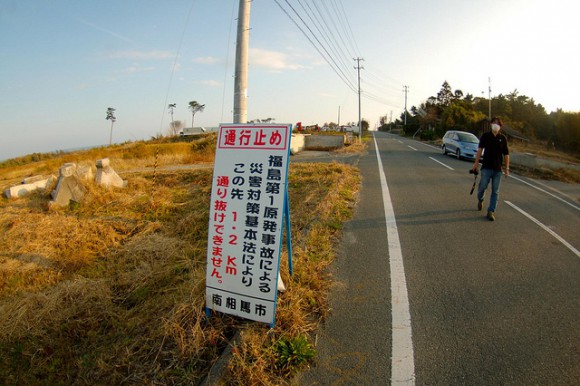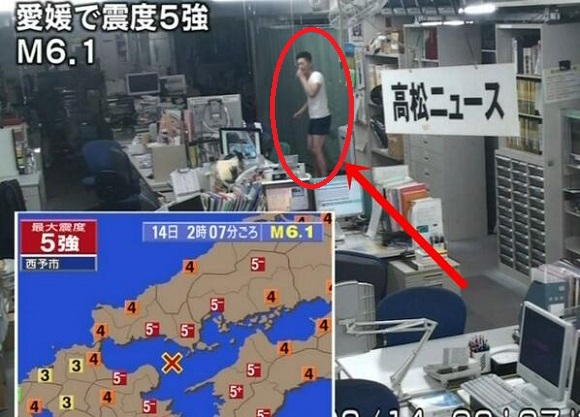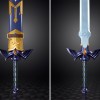Mobile kitchens provide comfort food, in the truest sense of the word, for thousands of earthquake victims.
earthquake (Page 3)
Two violent earthquakes and numerous strong aftershocks continue to rock the iconic 400-year-old castle, which has so far outlasted much younger structures.
I recently visited several areas of the Miyagi coastline decimated by the 2011 Tohoku earthquake and tsunami. This is what I saw.
Following the events of the 2011 Tohoku earthquake and tsunami and the subsequent meltdowns at the Fukushima Daiichi Nuclear Power Plant complex, radiologists in Japan have been closely observing the area for potential changes. A new report by the National Institute of Radiological Sciences now suggests that the fir trees in Fukushima may be exhibiting strange growth patterns, with the radiation from the disaster being named as a possible factor.
The first real earthquake I remember experiencing was on March 11, 2011. You might recognize that as the day of the Great Tohoku Earthquake, which brought the devastating tsunami that ravaged the northeastern coast of Japan. I was in Tokyo at the time, so the seismic activity was markedly lower than that experienced by people living in places like Iwate and Fukushima, but it was still a real shock.
Ever since, I’ve wondered just how much worse it must have been closer to the epicenter. Thanks to the Ikebukuro Life Safety Learning Center, I’ve come close to understanding what it must have felt like. Though far from anything you could describe as “fun,” it was an unquestionably powerful experience — and you can find out what it was like too. Check out our video introducing the center below, and learn a little bit about what to do in case you find yourself in caught in the middle of a powerful earthquake.
You might have heard that we experienced a magnitude-5.6 earthquake last week, which got everyone in the area a little shaken up (except for this super chill gorilla, of course). While Japan experiences earthquakes incredibly frequently, this one was a little bigger than usual, and had many in Japan diving for cover.
Oh, no, wait, they dived for their smartphones instead…
In the wake of the massive earthquake that struck central Nepal last week, non-profit organisation Peace Winds Japan sent a small team of six rescuers and two specially trained dogs to help with the search for survivors.
Remarkably, one of the search dogs who was dispatched to Kathmandu is himself a former rescue: Yumenosuke, a stray dog saved from euthanasia in Hiroshima.
Four years on, the earthquake, tsunami, and nuclear crisis that befell Japan’s Tohoku region on March 11, 2011 have very little effect on the day-to-day lives of most people in the country. The rolling blackouts have stopped. Batteries and bottled water are once again readily available. Trains are running, and whole cities aren’t spending hours walking home from work or school.
But while a return to normalcy is a desirable, and ultimately necessary, part of recovery, it’s also important to remember what happened. To stem the forgetfulness that often accompanies the later stages of coping with tragedy, on March 11 Yahoo! Japan will be making a donation to the Tohoku recovery efforts for every person that searches for “3.11” through the company’s search engine.
Japan is no stranger to earthquakes, meaning every time one occurs, the Japanese Twittersphere is bombarded with photos of the aftermath. There have been some major quakes that were no laughing matter, but usually, the tremors that occur result in nothing more than otaku griping about their toy…sorry, action figure collections getting knocked off the shelves. Japan’s most recent earthquake was centered around Ibaraki Prefecture and came in at a somewhat calm M5.6, delivering a few more photos of fallen treasures. From toppled heads to teetering TP, let’s take a look at some of the most popular photos taken after the earthquake.
According to Japanese scientists, Japan might be in for another big one.
Dr. Masaaki Kimura, a seismologist who reportedly predicted the 2011 Tohoku Earthquake, recently appeared on Japanese TV to share his theory about the next major earthquake to strike Japan. Based on his estimates, the quake will occur by 2017 and will be of similar magnitude to 2011’s. Similarly, astronomer Yoshio Kushida continues to insist that a big quake is not too far away. Keep reading to find out more about their respective theories and which specific areas of Japan they’ve got on the radar.
It’s always nice to be number one for something, even if it is number one in the “cities where the earth is most likely to kill you” ranking. That’s why we’re proud to announce that Tokyo and Yokohama were declared the cities at highest risk of natural disaster by Zurich-based Swiss Reinsurance (Swiss Re) in a 2013 study, whose findings were recently announced.
As you already know, the third anniversary of the 3/11 Tohoku disaster was remembered this week through a variety of activities, including a fundraiser by Yahoo! Japan which saw the company donating roughly $250,000 to charity. The anniversary was also marked by a powerful earthquake off the coast of Kyushu at around 2 am on March 12, injuring about 14 people and wrecking havoc on innocent anime figures.
It also brought grins to all of the NHK viewers and Twitter users who happened to catch the public broadcaster’s footage of a confused-looking man running around an office in his underwear!
Japan was hit by a magnitude 6.3 earthquake in the early hours of Friday morning which injured 14 people and caused a brief power outage in some areas. The quake, which struck off the coast of the southern island of Kyushu at 2:07am local time, caused only minor damage, but the third anniversary of the 2011 Tohoku earthquake this week served as an important reminder of the devastation that can be caused by major earthquakes and tsunami.
Japan is one of the most seismically active countries in the world, and as such its people tend to be extremely well-versed in what to do in the event of a natural disaster. Take cover, turn off the gas, open the door to secure an escape route. These collectors of anime figures, however, had a different idea about what to do in the moments after this morning’s quake – check up on their action figures, and immediately catalogue the damage on Twitter.
A special message is being displayed on Tokyo Tower in memory of those lost during the March 11, 2011 earthquake and resulting tsunami, as well as to promote a sense of unity across the country.
It’s been three years since the March 2011 Tohoku earthquake and tsunami disaster swallowed up whole cities and caused one of the worst nuclear power disasters in history. For much of the world the devastating event is a distant memory – except for people in California who, for some reason, to this day think swimming in the ocean is going to give them three eyes or four boobs or something.
But for many living near the crippled Dai-Ichi Nuclear Power Plant, like the inmates at a Kagoshima City prison located within the nuclear evacuation zone, the Tohoku earthquake and the persistent effects of the subsequent nuclear disaster altered their lives forever; so says a former inmate who is formally suing TEPCO for emotional distress.
At approximately 8:44 on the evening of 16 November, a magnitude-4 earthquake shook the Kanto area of Japan. Although some barely noticed the tremor, the quake dealt a sizeable blow to the Village Vanguard store in Sangenjaya, Tokyo.
Village Vanguard is a chain of book stores in Japan, but also the place to go for those looking for a Jamaican flag Zippo lighter, bag of freeze-dried astronaut food, DVD of Golden Eggs, and/or bag with a Dr. Pepper logo on it in a country that by and large neither knows of nor likes the drink.
Following the damage caused by the quake, an outpouring of support has been seen from netizens in Japan.
Being the most earthquake-prone country in the world, earthquake drills are as common in schools in Japan as fire drills are in the West. Knowledge of what to do and how to prepare for big quakes is essential, but many foreigners visiting or living in Japan are simply not used to larger tremors and have little or no idea how to respond should the earth start to rumble. Thankfully, even in Japan the chances of being hurt or killed in an earthquake are relatively slim, but it’s important to know what you can do to prepare. Combining our own first-hand experience with the expert advice of a seismologist from the California Institute of Technology, the following article not only discusses how best to respond in the event of an earthquake, but also lists the essential items that anyone living in Japan or any other earthquake-prone country should have stowed away in their earthquake preparedness kit.
Talking safety is never the most exciting subject, and no one’s asking you to go all Dwight Schrute and build a nuclear fallout shelter here, but it pays to be ready. And if the thought of tooling up in the name of earthquake preparedness fails to get your heart pumping, simply substitute the word “earthquake” for “zombie outbreak” and the process will become infinitely more fun.



















 Japanese government will check and judge new baby name pronunciations, presents guidelines
Japanese government will check and judge new baby name pronunciations, presents guidelines Station of despair: What to do if you get stuck at the end of Tokyo’s Chuo Rapid Line
Station of despair: What to do if you get stuck at the end of Tokyo’s Chuo Rapid Line Japanese train station vending machine has the best souvenirs for rail otaku
Japanese train station vending machine has the best souvenirs for rail otaku This downtown Tokyo cafe is like a time machine that takes you back 50 years into the past
This downtown Tokyo cafe is like a time machine that takes you back 50 years into the past Totoro towels gently glow in the dark to set the Ghibli nighttime mood in your home【Photos】
Totoro towels gently glow in the dark to set the Ghibli nighttime mood in your home【Photos】 Celebrating legal marriage days in Japan with budget-friendly photoshoots
Celebrating legal marriage days in Japan with budget-friendly photoshoots Shakey’s is back! All-you-can-eat pizza chain returns to downtown Tokyo’s Shinjuku
Shakey’s is back! All-you-can-eat pizza chain returns to downtown Tokyo’s Shinjuku Evangelion and McDonald’s Japan launch first-ever collaboration with transforming figures【Video】
Evangelion and McDonald’s Japan launch first-ever collaboration with transforming figures【Video】 Japan’s top 10 food travel destination prefectures【Survey】
Japan’s top 10 food travel destination prefectures【Survey】 Starbucks Japan just released a new matcha green tea latte, but is it any good?
Starbucks Japan just released a new matcha green tea latte, but is it any good? Japanese company develops classy heavy metal band frames for glasses
Japanese company develops classy heavy metal band frames for glasses One of Japan’s rarest sweets is a sell-out hit that looks and tastes like frost
One of Japan’s rarest sweets is a sell-out hit that looks and tastes like frost Studio Ghibli showcases traditional craftsmanship with new wallet range
Studio Ghibli showcases traditional craftsmanship with new wallet range Mysterious light-up rainy night-sound Totoro figure doesn’t actually show a scene from the anime
Mysterious light-up rainy night-sound Totoro figure doesn’t actually show a scene from the anime Major Japanese city is abolishing extracurricular activities at all of its middle schools
Major Japanese city is abolishing extracurricular activities at all of its middle schools Spirited Away and Princess Mononoke plushies show a softer side of formidable Ghibli characters
Spirited Away and Princess Mononoke plushies show a softer side of formidable Ghibli characters Possessing Harry Potter’s Sword of Godric Gryffindor is now illegal in Japan
Possessing Harry Potter’s Sword of Godric Gryffindor is now illegal in Japan Uniqlo announces first-ever collaboration with horror manga master Junji Ito【Photos】
Uniqlo announces first-ever collaboration with horror manga master Junji Ito【Photos】 J-pop mega star Ado reveals she’s been living in the U.S., may not understand language acquisition
J-pop mega star Ado reveals she’s been living in the U.S., may not understand language acquisition Starbucks Japan is calling it quits with paper straws
Starbucks Japan is calling it quits with paper straws Studio Ghibli releases new range of cardigans for anime fans
Studio Ghibli releases new range of cardigans for anime fans Japan’s most popular castle raising ticket prices by up to 200 percent for non-local tourists
Japan’s most popular castle raising ticket prices by up to 200 percent for non-local tourists Furikake rice seasoning sales are soaring, which is bad news for Japan as a whole
Furikake rice seasoning sales are soaring, which is bad news for Japan as a whole Studio Ghibli heroine cardigans give you warmth and strength to face everyday challenges
Studio Ghibli heroine cardigans give you warmth and strength to face everyday challenges Eight unforgettable hot springs, as recommended by Japan’s “Professor Bath”
Eight unforgettable hot springs, as recommended by Japan’s “Professor Bath” McDonald’s new Happy Meals offer up cute and practical Sanrio lifestyle goods
McDonald’s new Happy Meals offer up cute and practical Sanrio lifestyle goods Foreign tourists on Shinkansen bullet train break suitcase etiquette, angering local passengers
Foreign tourists on Shinkansen bullet train break suitcase etiquette, angering local passengers [Deleted] Article written for April Fool’s Day 2018
[Deleted] Article written for April Fool’s Day 2018 Japanese government to make first change to romanization spelling rules since the 1950s
Japanese government to make first change to romanization spelling rules since the 1950s Foreigner’s request for help in Tokyo makes us sad for the state of society
Foreigner’s request for help in Tokyo makes us sad for the state of society Japanese convenience store Family Mart announces abolishment of eat-in spaces
Japanese convenience store Family Mart announces abolishment of eat-in spaces Life-size vibrating Legend of Zelda Master Sword for sale from Nintendo【Photos】
Life-size vibrating Legend of Zelda Master Sword for sale from Nintendo【Photos】 Princesses, fruits, and blacksmiths: Study reveals the 30 most unusual family names in Japan
Princesses, fruits, and blacksmiths: Study reveals the 30 most unusual family names in Japan Studio Ghibli releases free-download board game — Here’s how to play it without reading Japanese
Studio Ghibli releases free-download board game — Here’s how to play it without reading Japanese Celebrating legal marriage days in Japan with budget-friendly photoshoots
Celebrating legal marriage days in Japan with budget-friendly photoshoots Shakey’s is back! All-you-can-eat pizza chain returns to downtown Tokyo’s Shinjuku
Shakey’s is back! All-you-can-eat pizza chain returns to downtown Tokyo’s Shinjuku Evangelion and McDonald’s Japan launch first-ever collaboration with transforming figures【Video】
Evangelion and McDonald’s Japan launch first-ever collaboration with transforming figures【Video】 Japan’s top 10 food travel destination prefectures【Survey】
Japan’s top 10 food travel destination prefectures【Survey】 Starbucks Japan just released a new matcha green tea latte, but is it any good?
Starbucks Japan just released a new matcha green tea latte, but is it any good? 10 great quirky museums to beat the Japan rainy season blues
10 great quirky museums to beat the Japan rainy season blues 16-year-old Japanese girls will no longer be allowed to marry, age of legal adulthood moves to 18
16-year-old Japanese girls will no longer be allowed to marry, age of legal adulthood moves to 18 Low price, free booze and curry, late check-out, and great location — Akihabara capsule hotel has it all
Low price, free booze and curry, late check-out, and great location — Akihabara capsule hotel has it all Better know a train nerd: 36 different classifications for Japan’s “densha otaku”
Better know a train nerd: 36 different classifications for Japan’s “densha otaku” Starbucks Japan releases a new Frappuccino that looks and tastes like a floral bouquet
Starbucks Japan releases a new Frappuccino that looks and tastes like a floral bouquet One of Japan’s rarest sweets is a sell-out hit that looks and tastes like frost
One of Japan’s rarest sweets is a sell-out hit that looks and tastes like frost